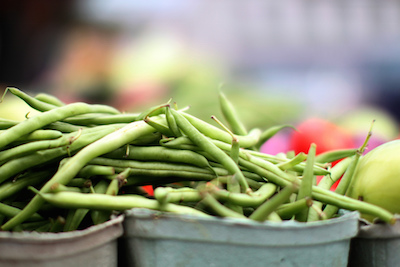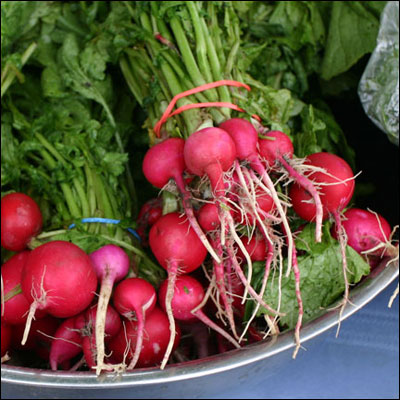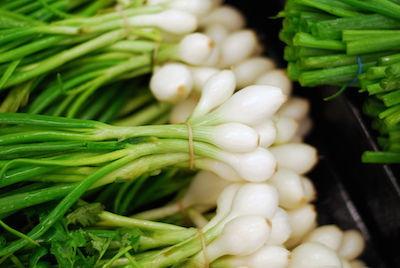Maybe it’s the influence of Portlandia creeping in, or maybe we’re all just addicted to the brine, but pickles are an enduring food trend. Chefs across the country are making all kinds of crazy pickles, but it’s just as easy to brine your own at home to spruce up your cheese plates or for simple, healthy (if a little salty) snacking.
The most important part of pickling is the brine, which is a basic mixture of one part vinegar to two parts water. For one quart of pickles, you’ll need two cups of water and one cup of vinegar. Bring the vinegar and water to a boil, and pour over the assembled mixture of veggies, salt, and spices to create a perfect pickle brine. You’ll also need pickling salt, which is free of iodine and anti-caking agents unlike regular table salt. Using regular table salt could result in a cloudy brine and unsightly settlement at the bottom of the jar.
If old-fashioned pickles are more your style, you could also try an old-school salt brine, or fermented pickles. You’ll just need to mix salt, water, and pickling spice to create this salt brine, which uses naturally occurring bacteria to ferment and pickle the vegetables. These pickles take a little more work — you’ll need to occasionally “burp” your jars to release gases that are created in fermentation, and allow to ferment for ten days.
The only elaborate step you’ll really have to take is sanitizing your jars. Fill up a large stock pot with enough water to cover the jars you plan to use, and boil for ten minutes. Use a silicone pot holder or canning tongs to remove the jars from the water, and allow to dry completely before using. For “quickles,” or quick pickles, you won’t need to do any of the canning process, but you will have to store your pickles in the refrigerator and consume them within a couple of weeks.
From there, the possibilities are really endless. Most of spring’s most delicious vegetables can be quick-pickled in as little as 24 hours. You can purchase pickling spice at most grocery stores, but you’re probably better off in mixing up your own favorite blends of spices. Coriander, dill seed, peppercorns, and mustard seeds are frequent fliers in the pickle world, and fresh and dried chiles can help add a little spice.
If you’ve wanted to try your hand at making those fancy pickles that you see in restaurants, you now have an easy process to use for your day of picklemaking. These six veggies hold up exceptionally well to being pickled, and the recipes are almost fool-proof. Mix up your own blends of herbs and spices to really impress your friends with your awesome pickle spread at the next dinner party.
Cauliflower
Cauliflower is a sturdy vegetable, which makes it perfect for quick pickling. Wash a head of fresh cauliflower thoroughly — dirt likes to hide in the little nooks and crannies — and chop it into small florets. From there, you can take any approach you want. You could try curry pickled cauliflower with turmeric, or go hot and spicy with the addition of a few fresh chili peppers. You could also just keep it simple and use the basic brine recipe, a little mustard seed, sugar, and red pepper flakes.
Carrots
Pickling is a really great way to utilize a large bag of carrots that you picked up on sale. Cut the peeled carrots into half-inch thick coins or thin spears, then plan to go absolutely crazy with the pickling spices. Try lemon, coriander, and cumin for a Moroccan-inspired pickle, or try David Leibovitz’s simple recipe that uses fennel seed, cider vinegar, and garlic for fresh, simple flavor.
Green Beans
“Dilly Beans” are a popular southern pickle, likely due to their addictive deliciousness. In my own recipe, I use the basic brine recipe, a couple tablespoons of dill seed, pickling salt, and cloves of garlic. A serrano pepper or teaspoon of red pepper flakes can add heat, and coriander adds a dose of interesting flavor. If you don’t trust me, you could always go with Martha Stewart’s recipe, which adds sugar, chiles, and peppercorns. After a few days, use your pickled green beans to garnish a bloody mary, or chop into a salad for interesting flavor and crunch.
Radishes
Radishes are perfectly spicy during the spring, making them a great addition to your pickle repertoire. They’re especially easy to lactoferment, only needing a little salt to produce a great pickle. If you’re feeling adventurous, try this recipe for bread n’ butter carrots, using mustard seeds and red wine vinegar. These are perfect on a quick spring sandwich, or by themselves straight from the jar.
Scallions
Once you’ve chopped the dark green tops off those green onions for use in other dishes, save the light green bottoms for pickling. You’ll need to trim them if you’re using pint jars, but you can leave the roots intact if they’ve been washed thoroughly. From there, you can add dill and mustard seeds to the basic brine for a simple pickle, or get a little crazier with spicy chiles and coriander. Use these to garnish Bloody Marys and martinis, or chop and mix into a salad in lieu of more pungent fresh onions.




